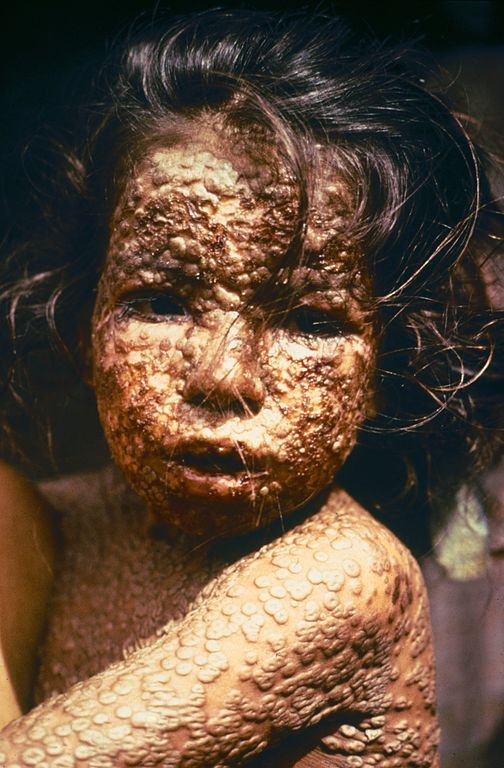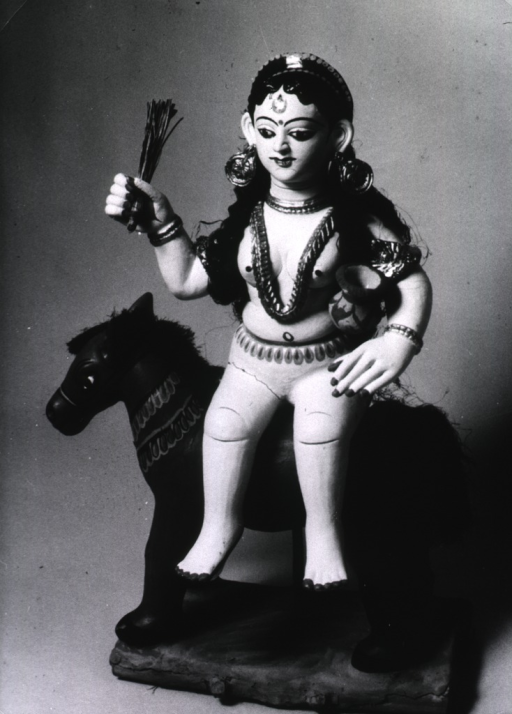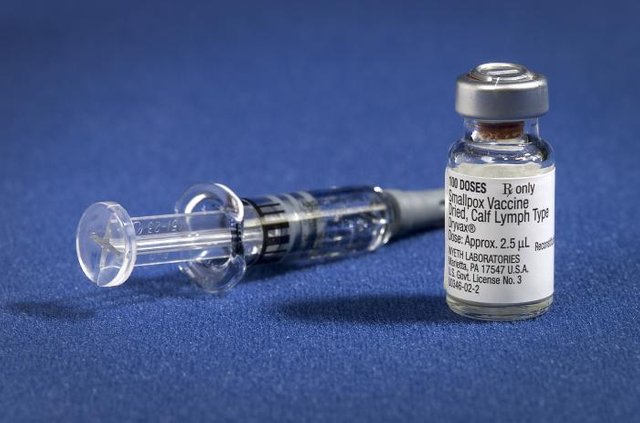The Rise and Fall of Smallpox
Epidemics of smallpox suddenly occurred all around the world during the Age of Exploration. Untold millions of people died from the disease. Was it solely spread by European voyagers? And where did smallpox originate?

A young girl infected with smallpox, 1973
The puzzle
A reader of my previous post noticed that I had written about a smallpox epidemic having a deadly impact on the indigenous Khoekhoe population in South Africa, in 1713 (and later in 1767). He asked whether smallpox comes from Europe or Africa. My first reaction was that was, of course, it came from Europe. Then I started digging around. It's a lot more complicated than that.
The first thing I did was to investigate the cause of the aforementioned smallpox outbreak. It seems it made its appearance when a ship docked in Cape Town with a smallpox-infected crew member. His clothes were taken out and washed in a stream near the Castle which contaminated the drinking water. Many of the white settler population were infected and suffered from the disease. But, as noted before, it was the Khoekhoe (Khoisan) people who suffered most - whole clans were wiped out. It was absolutely catastrophic for them.
But here's the thing: the ship had come from India.
So where did the crew member get infected? In Europe (assuming he was European) or in India?
The origins
Smallpox has been infecting humans for a long time. It probably emerged about 10,000 BCE. But the earliest evidence of it dates back to the Egyptian Empire around the 5,000 years ago, based on a smallpox-like rash found on three mummies.
There is written evidence of it from China in the 4th century and in India in the 7th century. It became so rooted in everyday life that smallpox started having its own gods. An example is Shitala Mata, the Indian goddess of smallpox (7th century):

By this time it had spread to Europe. An incontrovertible description of smallpox in Western Europe was given in 581. Large rural populations in all areas infected were wiped out. In the East, the epidemic of 735 to 737 is believed to have killed as much as one-third of the Japanese population.
This coincided with the 7th century Arab expansion into northern Africa, Spain and Portugal. Smallpox became endemic in all these regions. Things got worse when the returning Crusaders spread smallpox throughout Europe.
The spread
Is it coincidental that in the 15th century smallpox spread to other parts of the world by explorers largely from Spain and Portugal? It started with the occupation by the Portuguese of the west coast of Africa bringing smallpox to that region.
But things really hotted up in the 16th century when smallpox was spread to the western hemisphere. European colonisers and the Atlantic African slave trade spread the disease into the Caribbean and Central and South America. It had a devastating effect on the indigenous population. It took out the entire Aztec army with at least 25% of the Aztec population as a whole. One Spanish monk left this description:
As the Indians did not know the remedy of the disease…they died in heaps, like bedbugs. In many places it happened that everyone in a house died and, as it was impossible to bury the great number of dead, they pulled down the houses over them so that their homes become their tombs.
Smallpox marched on taking up to 90% of the Inca population. The west coast of South America had been shielded from the disease but in 1561 the new governor of Chile landed on its Pacific shore bringing the disease with him. It is estimated that about 25% of the population were killed by the disease.
In 1633 in Plymouth, Massachusetts, the Native Americans were struck by the virus. It wiped out entire population groups of Native Americans. A single gift of blankets and linen caused the death of up to 1.5 million Plains Indians. For the next two centuries massive depopulation ensued as tribe after tribe were wiped out.
On the east African coast, smallpox was taking its toll. The Arab slave trade was spreading it throughout the region. As the traders pushed further into the hinterland to capture more slaves they eventually ensured that smallpox was spread to the whole continent. As in the Americas, this had a devastating effect on the local population, with many tribes being wiped out.
It took some time, but in 1789 smallpox eventually arrived in Australia. At least 50% of the Aboriginal population on the coast were killed. It spread to the Pacific islands too. One late-comer was New Zealand, which had its first epidemic in 1913.
The fight back

It goes without saying that smallpox was a devastating disease. On average, 3 out of every 10 people who got it died. Those who survived were usually left with scars, which were sometimes severe.
So not surprisingly, the fightback to control the disease began early.
Very early on it was noticed that those who had contracted smallpox once were never struck by it again. It was also found that those who contracted smallpox through a break in the skin in which smallpox matter was inserted received a less severe reaction than those who contracted it naturally. This led to the intentional infection of people with smallpox matter, such as scabs, a process known as variolation. Besides quarantine, this was the sole method of protection against smallpox until Edward Jenner's discovery of the inoculating abilities of cowpox against the smallpox virus in 1796.
This was the turning point. Smallpox vaccination was used to immunise millions of people against the disease. Almost two centuries after Jenner published his hope that vaccination could annihilate smallpox, on May 8, 1980, the 33rd World Health Assembly officially declared the world free of this disease.
Eradication of smallpox is considered the biggest achievement in international public health.
References:
https://www.cdc.gov/smallpox/history/history.html
http://www.ancestors.co.za/smallpox-at-the-cape/
https://en.wikipedia.org/wiki/History_of_smallpox
Also posted on Weku, @tim-beck, 2018-10-30
Congratulations! Your post has been selected as a daily Steemit truffle! It is listed on rank 14 of all contributions awarded today. You can find the TOP DAILY TRUFFLE PICKS HERE.
I upvoted your contribution because to my mind your post is at least 6 SBD worth and should receive 89 votes. It's now up to the lovely Steemit community to make this come true.
I am
TrufflePig, an Artificial Intelligence Bot that helps minnows and content curators using Machine Learning. If you are curious how I select content, you can find an explanation here!Have a nice day and sincerely yours,

TrufflePig